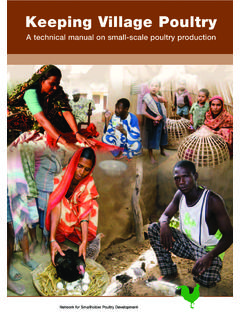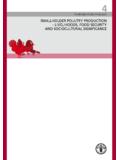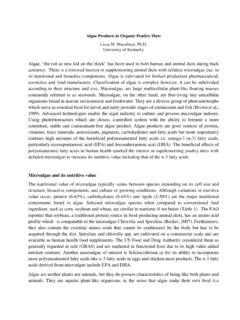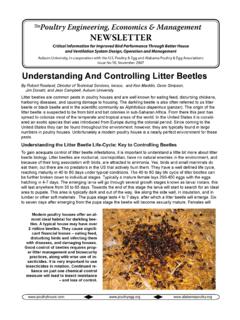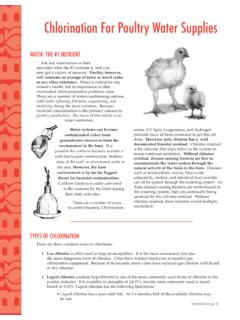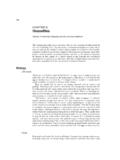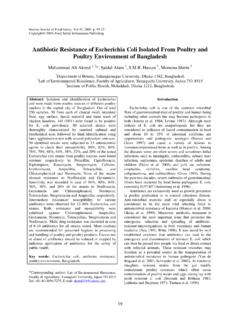Transcription of A toolbox talk on poultry dust - Health and Safety …
1 toolbox Talk User Guide A guide on how to use this PowerPoint presentation The Background poultry farming is a dusty business. In the enclosed environment of a poultry shed, poultry farm workers may be exposed to high concentrations of airborne organic dust ( poultry dust ). poultry dust is the term used to describe the dust , including any biological agents arising from work activities on poultry farms, including hatcheries. This presentation provides a short introductory or awareness-raising session on poultry dust . It explains what poultry dust is, the risk of getting respiratory disease through working in poultry farming and how to prevent it. It should take about 15 minutes to present. The presentation is designed to be delivered in the workplace as part of a training session, team meeting or induction for new starters. The presentation can be delivered by a Safety representative, supervisor or manager. Before you start Training is only one part of managing the risks of poultry dust .
2 All employers should have procedures in place to make sure that the risks are properly controlled. This includes assessing the risk from poultry dust within your own workplace and introducing appropriate controls. Further information is available at Using the talk Not all of the talk may be relevant to your site - leave out the parts that are not. There may also be some risks that apply to your site that have not been included. Before using the talk, check its contents against your own risk assessment and add any information that you think is necessary. Identify the people who are affected by poultry dust and make sure they are present when it is delivered. Keep a record of those who have received the talk and make other arrangements for anybody who cannot attend. The person who delivers the talk should: be a good speaker; be committed to what they say; be able to explain the risks associated with poultry dust ; and know enough about poultry dust and its effects to be able to answer any questions that may be asked.
3 While the talk can be read as written, it is important that whoever delivers it is comfortable with the language used. Where they are not, it should be modified to suit their own style of delivery. Instructions for giving the talk The presenter s notes are included in the notes which accompany each slide to provide you with the script for your presentation. Add your own notes to make the talk specific to your place of work. Use any local examples of good practice. Explain why awareness of poultry dust is important. Encourage workers to ask questions and if you have any difficulties seek further advice from your manager or an HSE inspector. Encourage discussion and agree some actions at the end of the presentation. Follow up points that have been raised after the presentation has been given, eg a further session on Respiratory Protective Equipment (RPE). Consider issuing a reminder card with the key points on. Introducing the toolbox talk Why talk about poultry dust ?
4 Slide 2 What to say poultry workers are at higher risk of respiratory diseases (diseases that affect our lungs and breathing tubes) when compared to other farmers. The talk is split into five sections: What is poultry dust ? Which activities generate poultry dust ? What happens when you breathe it in? Preventing occupational respiratory disease . Next steps .. what do we need to do next? After the talk, we will discuss and agree the next steps what actions should be taken in our workplace to prevent respiratory disease ? Section 1 - What is poultry dust ? Slide 3 What to say poultry dust is a mixture of bird feed, bedding material (eg wood shavings/shreds or straw), bird droppings, feathers and dander (dead skin), dust mites and storage mites, and micro-organisms such as bacteria, fungi (moulds) and endotoxins (cell wall components of bacteria). Breathing in these materials at the levels encountered in poultry farming and hatcheries may cause, or make worse, respiratory disease in poultry workers (a disease affecting our lungs and breathing tubes).
5 The organisms in the red boxes are not visible to the naked eye and need a powerful microscope to see them. Additional Notes Respiratory disease (a disease affecting our lungs and breathing tubes) is a major occupational Health risk for those working in agriculture, with the amount of occupational asthma cases double the national average. poultry production methods have moved towards industrial large-scale confinement facilities and studies have shown that poultry workers exposure to poultry dust can be substantial. Symptoms reported as very common in poultry workers include: coughing, phlegm, difficulty in breathing or catching breath, chest tightness, wheezing, sneezing, runny nose, eye irritation, headache, throat irritation and fever. Section 2 - Which activities generate poultry dust ? Slide 4 What to say Laying down bedding Tipping wood shavings will generate airborne dust as the material falls. Using a mechanical device to chop and spread straw material inside a poultry shed will generate airborne dust due to the speed and movement of the chopper/spreader.
6 Using an air blower to clear spillages outside a poultry shed will force bedding material into the air and generate airborne dust . Throwing wood shavings/straw or using a rake/shovel to spread bedding material will also generate airborne dust . Populating houses Tipping out trays of day-old chicks into a rearing shed or transferring point of lay hens from wheeled modules into cage/barn systems will raise airborne poultry dust , predominantly consisting of bird feathers, dander and mites. Section 2 - Which activities generate poultry dust ? Slide 5 What to say Routine cleaning Using an air blower to routinely clean down cage systems, walls, floors and associated machinery will generate airborne poultry dust due to the air from the blower forcing settled debris into the air. The use of a sweeping brush to clean floors or a duster to clean cages will generate airborne poultry dust . Catching (depopulation) Herding birds into a penned area, walking through birds to check on their welfare, and catching, vaccinating and loading birds into modules all generates airborne poultry dust from the movement of the birds (eg flapping wings will disturb feathers/dander/mites from the birds and disturb the litter material underfoot) and the catcher.
7 Section 2 - Which activities generate poultry dust ? Slide 6 What to say Litter removal Using a mechanical bucket to scoop, scrape, pile up and tip litter, and using a mechanically driven rotary brush will all generate airborne poultry dust due to the speed and movement of the mechanical bucket and rotary brush. Using a blower to remove litter from around roof supports/extensions will generate airborne poultry dust by blowing the litter into the air. Final clean Using compressed air, hand brushes and shovels to remove litter in awkward areas will all generate airborne poultry dust . Section 3 - What happens if you breathe it in? Slide 7 What to say Our respiratory or breathing system include the mouth, nose, lungs and the tubes that connect them. Occupational respiratory disease is a medical term used to describe diseases caused by, or made worse by, something you breathe in while at work, eg poultry dust . Workers with occupational respiratory disease may develop permanent breathing problems, becoming disabled, and unable to work.
8 This not only affects the individual worker, but also has wider cost implications for their employer and the poultry industry as a whole. Additional Notes The symptoms reported as very common in poultry workers include: coughing; phlegm; difficulty breathing or catching breath; chest tightness; wheezing; sneezing; runny nose; eye irritation; headache; throat irritation; and fever. Section 3 - Asthma Slide 8 What to say This is what can happen to you if you develop a respiratory disease such as occupational asthma from breathing in poultry dust . This may lead to acute attacks of coughing, wheezing and breathlessness at or after work. In the longer term these symptoms can become more permanent, affecting your personal and working life. It is much better to prevent respiratory disease by using good working practices. Additional Notes Some occupational respiratory diseases affect the tubes that carry air in and out of the lungs (our airways).
9 Occupational asthma is an example of this sort of problem and is caused by an allergy to something in the workplace, eg poultry dust . This type of allergy usually takes several months or even years to develop, and may also cause eye and nasal symptoms at work. Occupational asthma causes the airways to swell and tighten; leading to symptoms of coughing, wheezing, chest tightness or breathlessness at or after work. If these symptoms are better on non-work days (such as weekends, rest days or holidays) then occupational asthma needs to be strongly considered. As well as causing asthma, working with poultry dusts can also worsen symptoms in those who already have asthma. Section 4 - Preventing respiratory disease Slide 9 What to say This is what you can do to prevent respiratory disease . Each of these is important. Section 4 - Protect your lungs and breathing tubes Slide 10 What to say Use a mask that is CE marked. Use a dust mask that is either FFP2 or FFP3.
10 Don t use nuisance masks. They do not stop you inhaling the small dust particles which are the most dangerous. Additional Notes CE mark The CE mark on RPE tells you that the equipment has met the minimum requirements laid down in the law for its design and manufacture. The law requires that RPE supplied for use at work must be CE marked. dust mask These trap and hold particles ( poultry dust ) from the air flowing through them. dust masks will be marked with FFP1, FFP2 or FFP3, and the higher the number the greater the protection (eg an FFP3 dust mask provides a higher protection than an FFP2 dust mask). Powered filtering hood/visor A filter for a fan-assisted respirator will also carry the sign TH and the filtration efficiency number (1, 2 or 3). The colour of the label will be white. Use a powered filtering hood/visor with a particle filter that is classified as either TH2 or TH3. Section 4 - dust masks Slide 11 What to say A fit test should be carried out as part of the initial selection of your dust mask.










